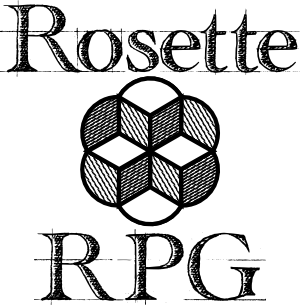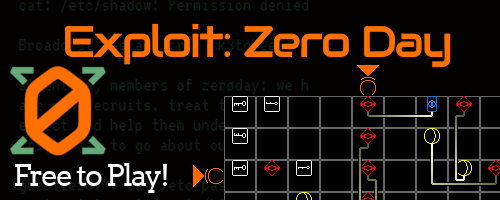
We're fans of Live-Action Roleplaying, or LARP, at Future Proof Games. Not particularly the kind where you run around in the woods with foam swords; more the sort where you dress up as vampires and talk to each other. We've played a lot of theatrical LARP, mostly using the Mind's Eye Theatre rules in a modern horror context. However, while we love crafting stories and doing improvisational roleplaying with people in interesting settings, we have issues with the social situations that have arisen in the games we played.
When we were starting up a new science-fiction-themed game with some friends, we decided we wanted to use a system that was more collaborative and incorporated consent directly into its rules framework. As luck would happen, we had a work-in-progress that seemed perfect: Rosette, our tabletop roleplaying game that focuses on quick, creative collaboration.
However, for Rosette to work in a LARP setting, it needed some major adjustments.
Conflict Resolution
In LARP you embody your character: sitting, standing, or walking around as the scene and your actions demand. Because of that, there's not always a handy surface nearby for dice-rolling. Some rules systems replace dice with drawn cards (which are awkward) or rock-paper-scissors matches (which can feel silly). Others remove uncertainty from challenges entirely and just compare your ability directly to an obstacle's difficulty, making it either guaranteed or impossible to overcome a given obstacle with your character.
We enjoy the tension of not being sure whether you will succeed at a challenge, but we aren't particularly devoted to the idea of randomness in games. We took the approach of directly comparing a character's ability to the difficulty of a challenge, but with the twist of letting you spend resources to "boost" your ability. Instead of Skills adding to a roll as they do in tabletop Rosette, in the LARP rules Skills are resources that you can spend to double your ability in a relevant area.
The tension of a random roll or card pull is replaced with the tension of picking which Skill (or Quirk or social Tie) to use on a challenge, wondering whether you'll need that resource later. As a session progresses, your resources dwindle and conflicts become more imposing. The binary nature of challenges ("do I boost or not?") also reduces the amount of arithmetic that needs to be done in the moment, keeping the focus on the story.
Decentralized Authority
In tabletop it works fine to have a single gamemaster in the traditional style: one person who plans story and challenges and serves as a judge in case of a rules question. However, LARP doesn't happen around a table; it can split up into different groups and rooms and result in gamemasters being unavailable when needed. Additionally, the most satisfying LARP interactions feel like improv theatre and pausing to consult the rules can disrupt that flow.
Our rules decentralize story authority. Anyone can hop into the role of Narrator and run larger story, and players are always allowed to introduce new non-player characters or setting elements when not in a Narrated scene. To help manage the scope of these story changes, we're using an "Except" gesture (based on the ASL for "but") so that players can ask each other to limit or qualify their setting contributions. For example, if I announced that my character had set up a force field that made surveillance of a room impossible, another player could give the "Except" gesture and I could qualify by saying that the force field could be overcome by an illegal piece of jamming technology.
This is all enabled by our efforts to establish a culture of consensus within our group, by the way Rosette's rules focus on consent, and by the principles of improv where you try to "say yes" to things people introduce while also setting them up to shine.
Pacing and Balance
LARP has a different flow than tabletop. In tabletop, extended conversation between PCs can often feel like a distraction because it delays the broader story and leaves the GM with little to do. In LARP, however, a conversation can more easily happen off to the side while other players focus on a longer-term task. Likewise, rules which are mechanically interesting when sitting at a table with a worksheet in front of you can feel onerous when moving around the room in costume.
To account for the different pacing and focus of LARP, several of Rosette's core rules were adjusted. We reduced characters' number of condition levels from five to three, reducing the amount of stress they can receive in a conflict before they're incapacitated. This will hopefully cause conflicts to move faster and not get in the way of more freeform socialization.
We also reduced the starting number of qualities characters have: for example, characters have five skills instead of fifteen. This accounts for the fact that skills are more powerful, reduces the amount of time players spend browsing through their character sheet, and makes the expenditure of skills in challenges feel more important.
Actual Play
So how does it feel in practice? We're still figuring that out. We've only played two sessions so far, but it seems promising. Character creation was pretty smooth, with only some confusion surrounding the meanings of certain qualities. Players are comfortable using their skills and traits in creative ways.
Conflict, which was a hard thing to get right in tabletop, is still a learning experience for all of the players. We hope that as we become more familiar with the rules and the intended flow of conflict that it will become more seamless. For now, however, there's a distracting mode switch between easy social interaction and the regimented structure of conflict scenes.
We think these rules have potential! There's a lot of design space to explore in LARPs between the very rules-heavy domain of Mind's Eye Theatre or boffer LARPs and the very open, experimental spaces of jeepform and Nordic LARP. Once we feel comfortable that Rosette LARP has found a comfortable place, we look forward to releasing it for more people to play.
What do you think about the intricacies of LARP design? Any questions or suggestions? Share your thoughts in the comments.




 View on YouTube
View on YouTube

